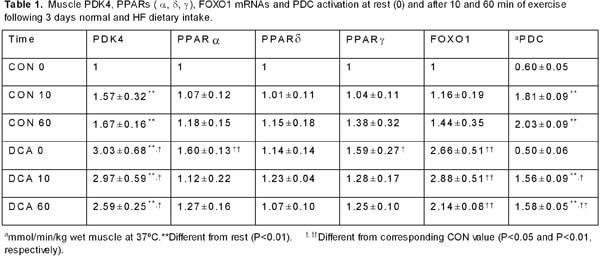Increasing lipid availability and oxidation suppresses skeletal muscle CHO oxidation by inhibiting pyruvate dehydrogenase complex (PDC) activity; via enhanced expression of pyruvate dehydrogenase kinase (PDK) isoform 4 protein (1, 2), that phosphorylates (inactivates) PDC. Signalling involving the peroxisome-proliferator-activated receptor (PPARα, δ, γ) and the sub-family of forkhead transcription factors (FOXO) is suggested to increase PDK4 protein (1, 3). We aimed to determine (i) the relevance of this signalling in vivo in humans by using high fat (HF) feeding to reduce muscle PDC activation, and (ii) whether calcium mediated activation of PDC (via PDC phosphatase) during exercise reversed any dietary mediated inhibition of PDC, and impacted on the above signalling pathways. On 2 randomised occasions, 6 healthy men (22.0±0.6 yr, 24.9±1.4 kg/m2) consumed either a “normal” (55% CHO, 30% fat, 15% protein; CON) or a HF (10 % CHO, 75% fat, 15% protein) isoenergetic diet for 3 days. A resting quadriceps biopsy sample was obtained the morning after (fasted), and subjects then cycling at 75% VO2max for 60 min. Further biopsies were taken after 10 and 60 min exercise. Subjects repeated the same procedures 7 days later, but consumed the alternative diet. Muscle was used to determine PPARs (α, δ, γ), PDK4, FOXO1 mRNAs and PDC activation status (Table 1). Statistical differences were located using repeated measures ANOVA. All values are mean+SE. HF feeding increased resting PDK4 mRNA 3-fold, and is likely to have resulted from increases in PPAR α and γ (1.5-fold) and FOXO1 (3-fold) transcription. Exercise activated PDC in CON and HF, but the magnitude of increase was blunted in HF, and may have been caused by PDK4 and FOXO1 mRNA expression being sustained throughout exercise.
Life Sciences 2007 (2007) Proc Life Sciences, PC75
Poster Communications: Molecular mechanism responsible for dietary fat mediated inhibition of PDC activation in human skeletal muscle, which is not reversed by acute contraction
T. Constantin1, D. Constantin1, F. Stephens1, D. Laithwaite1, P. Greenhaff1
1. Centre for Integrated Systems Biology & Medicine, School of Biomedical Sciences, Notttingham, Notts, United Kingdom.
View other abstracts by:
Where applicable, experiments conform with Society ethical requirements.

